Evolution of DNA Technology and Its Use in Criminal Justice System
VerifiedAdded on 2023/06/15
|7
|2421
|297
AI Summary
This essay discusses the history, evolution, and usage of DNA technology in the criminal justice system. It covers the process of DNA testing, its application in identifying suspects and solving crimes, and the ethical concerns surrounding its use.
Contribute Materials
Your contribution can guide someone’s learning journey. Share your
documents today.
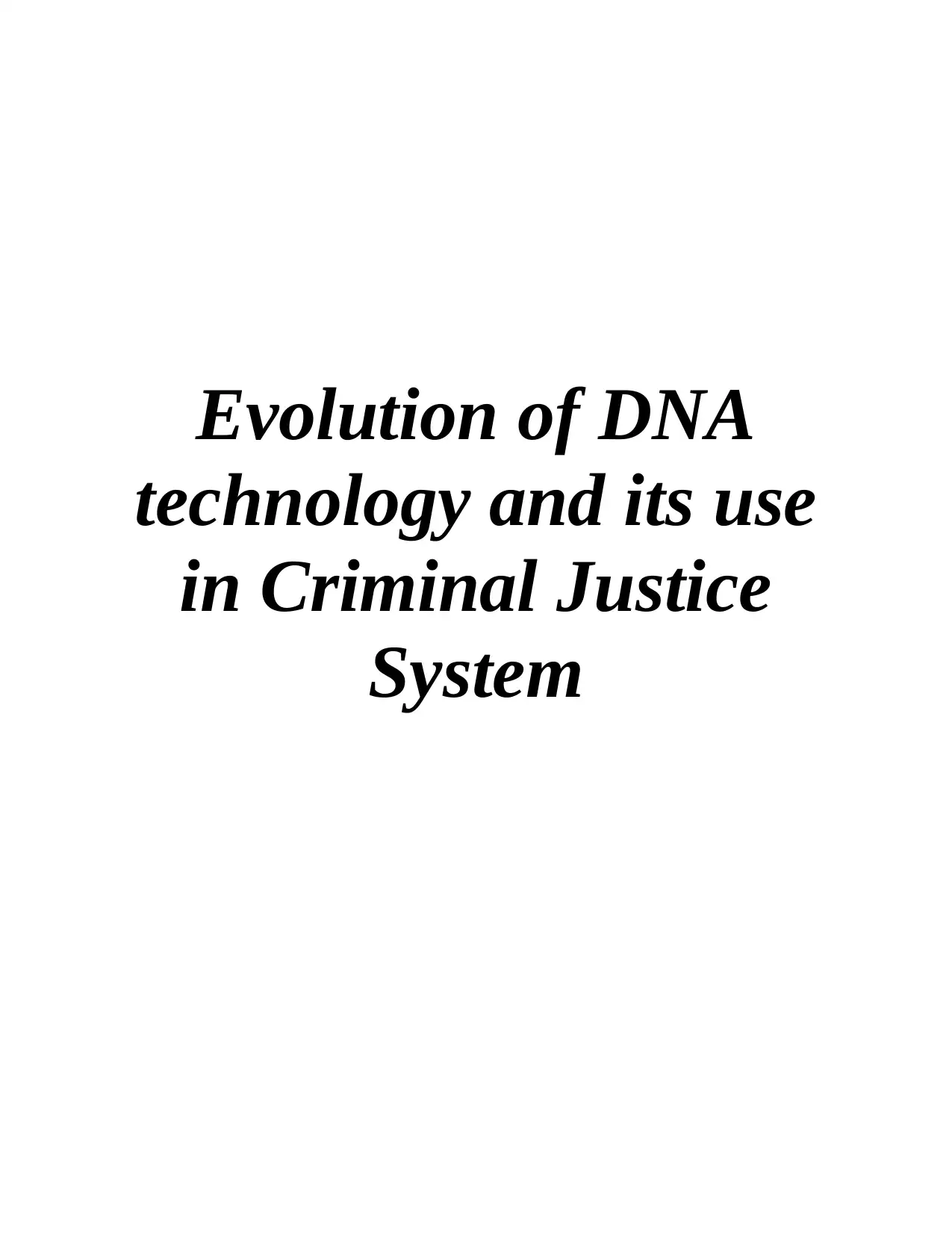
Evolution of DNA
technology and its use
in Criminal Justice
System
technology and its use
in Criminal Justice
System
Secure Best Marks with AI Grader
Need help grading? Try our AI Grader for instant feedback on your assignments.
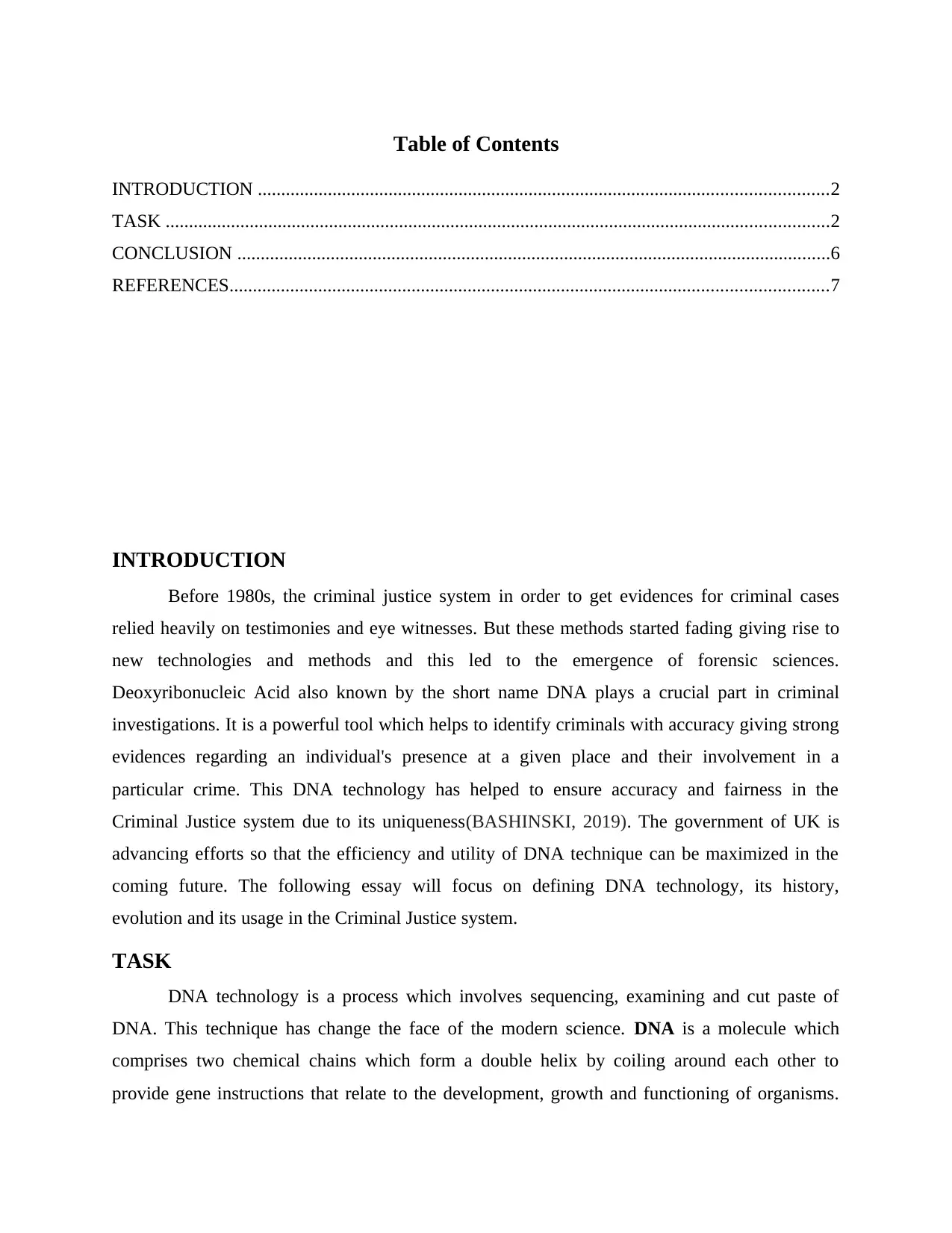
Table of Contents
INTRODUCTION ..........................................................................................................................2
TASK ..............................................................................................................................................2
CONCLUSION ...............................................................................................................................6
REFERENCES................................................................................................................................7
INTRODUCTION
Before 1980s, the criminal justice system in order to get evidences for criminal cases
relied heavily on testimonies and eye witnesses. But these methods started fading giving rise to
new technologies and methods and this led to the emergence of forensic sciences.
Deoxyribonucleic Acid also known by the short name DNA plays a crucial part in criminal
investigations. It is a powerful tool which helps to identify criminals with accuracy giving strong
evidences regarding an individual's presence at a given place and their involvement in a
particular crime. This DNA technology has helped to ensure accuracy and fairness in the
Criminal Justice system due to its uniqueness(BASHINSKI, 2019). The government of UK is
advancing efforts so that the efficiency and utility of DNA technique can be maximized in the
coming future. The following essay will focus on defining DNA technology, its history,
evolution and its usage in the Criminal Justice system.
TASK
DNA technology is a process which involves sequencing, examining and cut paste of
DNA. This technique has change the face of the modern science. DNA is a molecule which
comprises two chemical chains which form a double helix by coiling around each other to
provide gene instructions that relate to the development, growth and functioning of organisms.
INTRODUCTION ..........................................................................................................................2
TASK ..............................................................................................................................................2
CONCLUSION ...............................................................................................................................6
REFERENCES................................................................................................................................7
INTRODUCTION
Before 1980s, the criminal justice system in order to get evidences for criminal cases
relied heavily on testimonies and eye witnesses. But these methods started fading giving rise to
new technologies and methods and this led to the emergence of forensic sciences.
Deoxyribonucleic Acid also known by the short name DNA plays a crucial part in criminal
investigations. It is a powerful tool which helps to identify criminals with accuracy giving strong
evidences regarding an individual's presence at a given place and their involvement in a
particular crime. This DNA technology has helped to ensure accuracy and fairness in the
Criminal Justice system due to its uniqueness(BASHINSKI, 2019). The government of UK is
advancing efforts so that the efficiency and utility of DNA technique can be maximized in the
coming future. The following essay will focus on defining DNA technology, its history,
evolution and its usage in the Criminal Justice system.
TASK
DNA technology is a process which involves sequencing, examining and cut paste of
DNA. This technique has change the face of the modern science. DNA is a molecule which
comprises two chemical chains which form a double helix by coiling around each other to
provide gene instructions that relate to the development, growth and functioning of organisms.
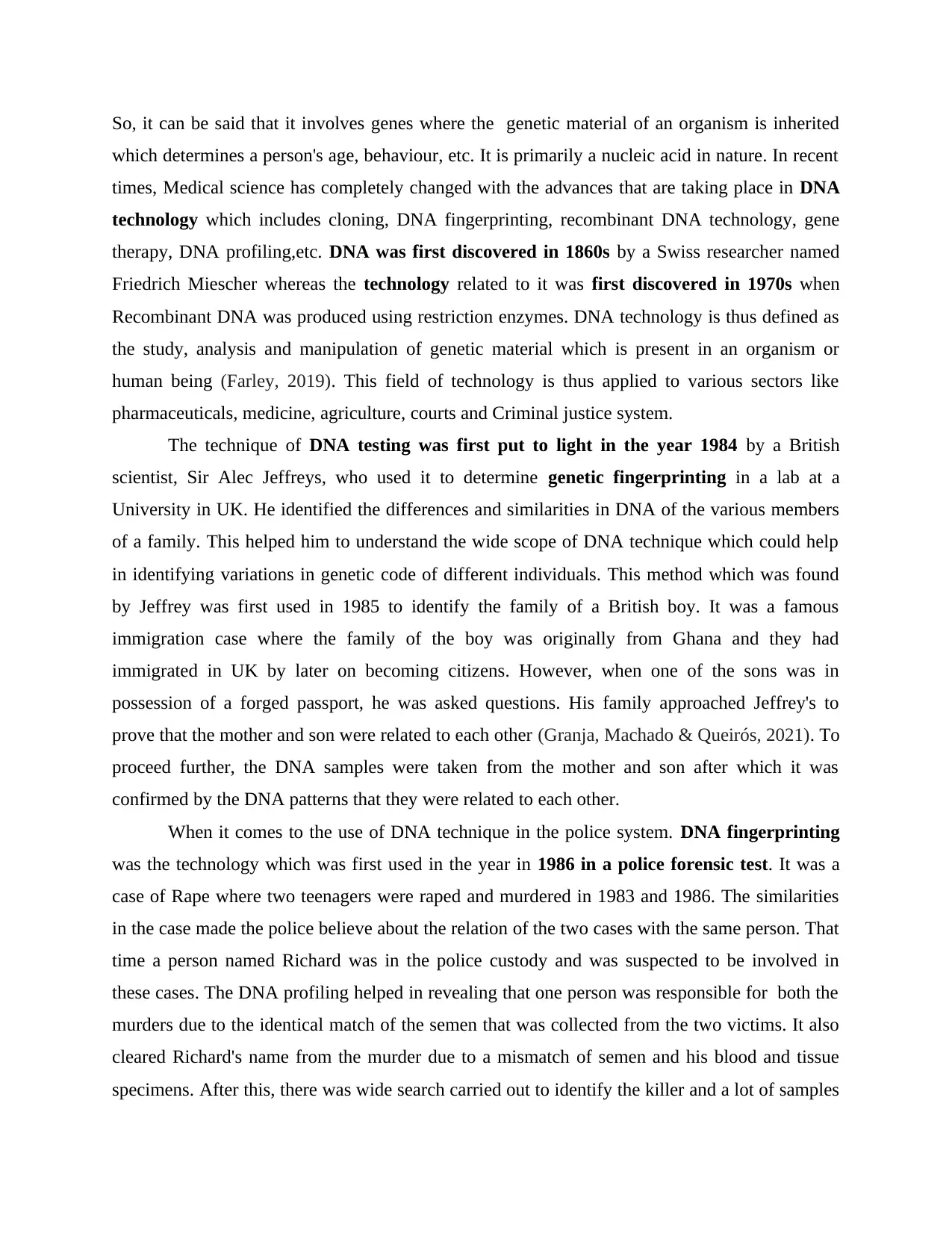
So, it can be said that it involves genes where the genetic material of an organism is inherited
which determines a person's age, behaviour, etc. It is primarily a nucleic acid in nature. In recent
times, Medical science has completely changed with the advances that are taking place in DNA
technology which includes cloning, DNA fingerprinting, recombinant DNA technology, gene
therapy, DNA profiling,etc. DNA was first discovered in 1860s by a Swiss researcher named
Friedrich Miescher whereas the technology related to it was first discovered in 1970s when
Recombinant DNA was produced using restriction enzymes. DNA technology is thus defined as
the study, analysis and manipulation of genetic material which is present in an organism or
human being (Farley, 2019). This field of technology is thus applied to various sectors like
pharmaceuticals, medicine, agriculture, courts and Criminal justice system.
The technique of DNA testing was first put to light in the year 1984 by a British
scientist, Sir Alec Jeffreys, who used it to determine genetic fingerprinting in a lab at a
University in UK. He identified the differences and similarities in DNA of the various members
of a family. This helped him to understand the wide scope of DNA technique which could help
in identifying variations in genetic code of different individuals. This method which was found
by Jeffrey was first used in 1985 to identify the family of a British boy. It was a famous
immigration case where the family of the boy was originally from Ghana and they had
immigrated in UK by later on becoming citizens. However, when one of the sons was in
possession of a forged passport, he was asked questions. His family approached Jeffrey's to
prove that the mother and son were related to each other (Granja, Machado & Queirós, 2021). To
proceed further, the DNA samples were taken from the mother and son after which it was
confirmed by the DNA patterns that they were related to each other.
When it comes to the use of DNA technique in the police system. DNA fingerprinting
was the technology which was first used in the year in 1986 in a police forensic test. It was a
case of Rape where two teenagers were raped and murdered in 1983 and 1986. The similarities
in the case made the police believe about the relation of the two cases with the same person. That
time a person named Richard was in the police custody and was suspected to be involved in
these cases. The DNA profiling helped in revealing that one person was responsible for both the
murders due to the identical match of the semen that was collected from the two victims. It also
cleared Richard's name from the murder due to a mismatch of semen and his blood and tissue
specimens. After this, there was wide search carried out to identify the killer and a lot of samples
which determines a person's age, behaviour, etc. It is primarily a nucleic acid in nature. In recent
times, Medical science has completely changed with the advances that are taking place in DNA
technology which includes cloning, DNA fingerprinting, recombinant DNA technology, gene
therapy, DNA profiling,etc. DNA was first discovered in 1860s by a Swiss researcher named
Friedrich Miescher whereas the technology related to it was first discovered in 1970s when
Recombinant DNA was produced using restriction enzymes. DNA technology is thus defined as
the study, analysis and manipulation of genetic material which is present in an organism or
human being (Farley, 2019). This field of technology is thus applied to various sectors like
pharmaceuticals, medicine, agriculture, courts and Criminal justice system.
The technique of DNA testing was first put to light in the year 1984 by a British
scientist, Sir Alec Jeffreys, who used it to determine genetic fingerprinting in a lab at a
University in UK. He identified the differences and similarities in DNA of the various members
of a family. This helped him to understand the wide scope of DNA technique which could help
in identifying variations in genetic code of different individuals. This method which was found
by Jeffrey was first used in 1985 to identify the family of a British boy. It was a famous
immigration case where the family of the boy was originally from Ghana and they had
immigrated in UK by later on becoming citizens. However, when one of the sons was in
possession of a forged passport, he was asked questions. His family approached Jeffrey's to
prove that the mother and son were related to each other (Granja, Machado & Queirós, 2021). To
proceed further, the DNA samples were taken from the mother and son after which it was
confirmed by the DNA patterns that they were related to each other.
When it comes to the use of DNA technique in the police system. DNA fingerprinting
was the technology which was first used in the year in 1986 in a police forensic test. It was a
case of Rape where two teenagers were raped and murdered in 1983 and 1986. The similarities
in the case made the police believe about the relation of the two cases with the same person. That
time a person named Richard was in the police custody and was suspected to be involved in
these cases. The DNA profiling helped in revealing that one person was responsible for both the
murders due to the identical match of the semen that was collected from the two victims. It also
cleared Richard's name from the murder due to a mismatch of semen and his blood and tissue
specimens. After this, there was wide search carried out to identify the killer and a lot of samples
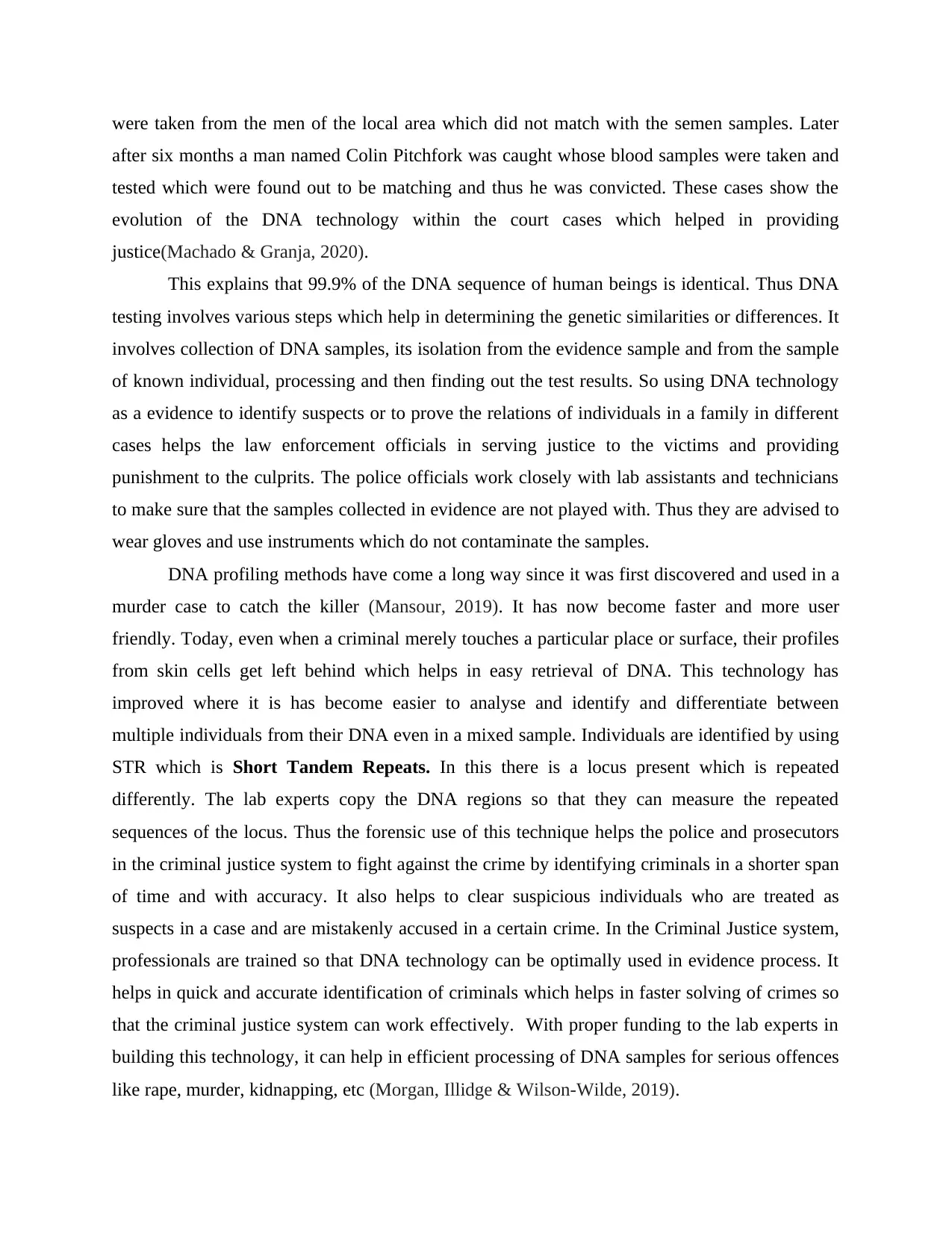
were taken from the men of the local area which did not match with the semen samples. Later
after six months a man named Colin Pitchfork was caught whose blood samples were taken and
tested which were found out to be matching and thus he was convicted. These cases show the
evolution of the DNA technology within the court cases which helped in providing
justice(Machado & Granja, 2020).
This explains that 99.9% of the DNA sequence of human beings is identical. Thus DNA
testing involves various steps which help in determining the genetic similarities or differences. It
involves collection of DNA samples, its isolation from the evidence sample and from the sample
of known individual, processing and then finding out the test results. So using DNA technology
as a evidence to identify suspects or to prove the relations of individuals in a family in different
cases helps the law enforcement officials in serving justice to the victims and providing
punishment to the culprits. The police officials work closely with lab assistants and technicians
to make sure that the samples collected in evidence are not played with. Thus they are advised to
wear gloves and use instruments which do not contaminate the samples.
DNA profiling methods have come a long way since it was first discovered and used in a
murder case to catch the killer (Mansour, 2019). It has now become faster and more user
friendly. Today, even when a criminal merely touches a particular place or surface, their profiles
from skin cells get left behind which helps in easy retrieval of DNA. This technology has
improved where it is has become easier to analyse and identify and differentiate between
multiple individuals from their DNA even in a mixed sample. Individuals are identified by using
STR which is Short Tandem Repeats. In this there is a locus present which is repeated
differently. The lab experts copy the DNA regions so that they can measure the repeated
sequences of the locus. Thus the forensic use of this technique helps the police and prosecutors
in the criminal justice system to fight against the crime by identifying criminals in a shorter span
of time and with accuracy. It also helps to clear suspicious individuals who are treated as
suspects in a case and are mistakenly accused in a certain crime. In the Criminal Justice system,
professionals are trained so that DNA technology can be optimally used in evidence process. It
helps in quick and accurate identification of criminals which helps in faster solving of crimes so
that the criminal justice system can work effectively. With proper funding to the lab experts in
building this technology, it can help in efficient processing of DNA samples for serious offences
like rape, murder, kidnapping, etc (Morgan, Illidge & Wilson-Wilde, 2019).
after six months a man named Colin Pitchfork was caught whose blood samples were taken and
tested which were found out to be matching and thus he was convicted. These cases show the
evolution of the DNA technology within the court cases which helped in providing
justice(Machado & Granja, 2020).
This explains that 99.9% of the DNA sequence of human beings is identical. Thus DNA
testing involves various steps which help in determining the genetic similarities or differences. It
involves collection of DNA samples, its isolation from the evidence sample and from the sample
of known individual, processing and then finding out the test results. So using DNA technology
as a evidence to identify suspects or to prove the relations of individuals in a family in different
cases helps the law enforcement officials in serving justice to the victims and providing
punishment to the culprits. The police officials work closely with lab assistants and technicians
to make sure that the samples collected in evidence are not played with. Thus they are advised to
wear gloves and use instruments which do not contaminate the samples.
DNA profiling methods have come a long way since it was first discovered and used in a
murder case to catch the killer (Mansour, 2019). It has now become faster and more user
friendly. Today, even when a criminal merely touches a particular place or surface, their profiles
from skin cells get left behind which helps in easy retrieval of DNA. This technology has
improved where it is has become easier to analyse and identify and differentiate between
multiple individuals from their DNA even in a mixed sample. Individuals are identified by using
STR which is Short Tandem Repeats. In this there is a locus present which is repeated
differently. The lab experts copy the DNA regions so that they can measure the repeated
sequences of the locus. Thus the forensic use of this technique helps the police and prosecutors
in the criminal justice system to fight against the crime by identifying criminals in a shorter span
of time and with accuracy. It also helps to clear suspicious individuals who are treated as
suspects in a case and are mistakenly accused in a certain crime. In the Criminal Justice system,
professionals are trained so that DNA technology can be optimally used in evidence process. It
helps in quick and accurate identification of criminals which helps in faster solving of crimes so
that the criminal justice system can work effectively. With proper funding to the lab experts in
building this technology, it can help in efficient processing of DNA samples for serious offences
like rape, murder, kidnapping, etc (Morgan, Illidge & Wilson-Wilde, 2019).
Secure Best Marks with AI Grader
Need help grading? Try our AI Grader for instant feedback on your assignments.
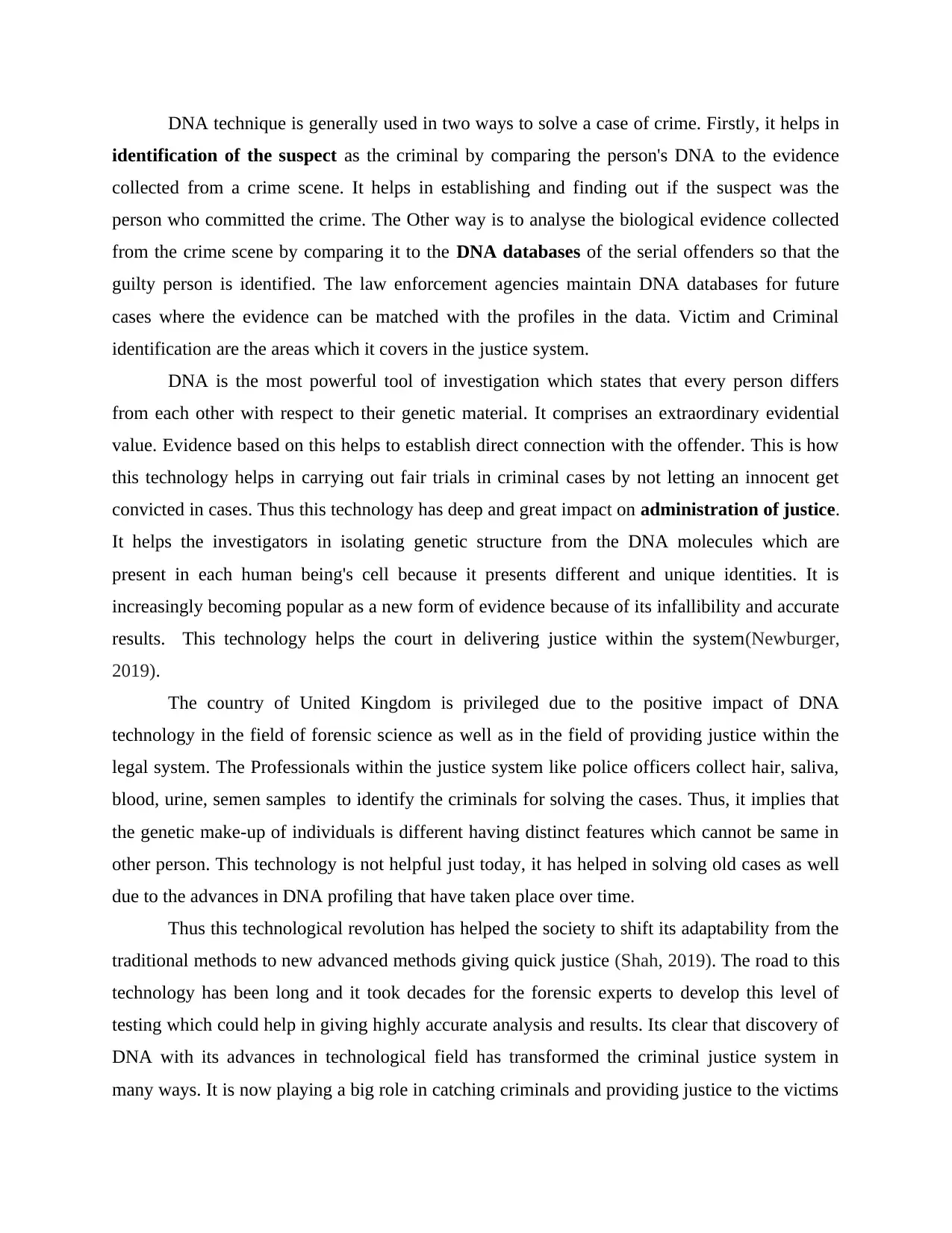
DNA technique is generally used in two ways to solve a case of crime. Firstly, it helps in
identification of the suspect as the criminal by comparing the person's DNA to the evidence
collected from a crime scene. It helps in establishing and finding out if the suspect was the
person who committed the crime. The Other way is to analyse the biological evidence collected
from the crime scene by comparing it to the DNA databases of the serial offenders so that the
guilty person is identified. The law enforcement agencies maintain DNA databases for future
cases where the evidence can be matched with the profiles in the data. Victim and Criminal
identification are the areas which it covers in the justice system.
DNA is the most powerful tool of investigation which states that every person differs
from each other with respect to their genetic material. It comprises an extraordinary evidential
value. Evidence based on this helps to establish direct connection with the offender. This is how
this technology helps in carrying out fair trials in criminal cases by not letting an innocent get
convicted in cases. Thus this technology has deep and great impact on administration of justice.
It helps the investigators in isolating genetic structure from the DNA molecules which are
present in each human being's cell because it presents different and unique identities. It is
increasingly becoming popular as a new form of evidence because of its infallibility and accurate
results. This technology helps the court in delivering justice within the system(Newburger,
2019).
The country of United Kingdom is privileged due to the positive impact of DNA
technology in the field of forensic science as well as in the field of providing justice within the
legal system. The Professionals within the justice system like police officers collect hair, saliva,
blood, urine, semen samples to identify the criminals for solving the cases. Thus, it implies that
the genetic make-up of individuals is different having distinct features which cannot be same in
other person. This technology is not helpful just today, it has helped in solving old cases as well
due to the advances in DNA profiling that have taken place over time.
Thus this technological revolution has helped the society to shift its adaptability from the
traditional methods to new advanced methods giving quick justice (Shah, 2019). The road to this
technology has been long and it took decades for the forensic experts to develop this level of
testing which could help in giving highly accurate analysis and results. Its clear that discovery of
DNA with its advances in technological field has transformed the criminal justice system in
many ways. It is now playing a big role in catching criminals and providing justice to the victims
identification of the suspect as the criminal by comparing the person's DNA to the evidence
collected from a crime scene. It helps in establishing and finding out if the suspect was the
person who committed the crime. The Other way is to analyse the biological evidence collected
from the crime scene by comparing it to the DNA databases of the serial offenders so that the
guilty person is identified. The law enforcement agencies maintain DNA databases for future
cases where the evidence can be matched with the profiles in the data. Victim and Criminal
identification are the areas which it covers in the justice system.
DNA is the most powerful tool of investigation which states that every person differs
from each other with respect to their genetic material. It comprises an extraordinary evidential
value. Evidence based on this helps to establish direct connection with the offender. This is how
this technology helps in carrying out fair trials in criminal cases by not letting an innocent get
convicted in cases. Thus this technology has deep and great impact on administration of justice.
It helps the investigators in isolating genetic structure from the DNA molecules which are
present in each human being's cell because it presents different and unique identities. It is
increasingly becoming popular as a new form of evidence because of its infallibility and accurate
results. This technology helps the court in delivering justice within the system(Newburger,
2019).
The country of United Kingdom is privileged due to the positive impact of DNA
technology in the field of forensic science as well as in the field of providing justice within the
legal system. The Professionals within the justice system like police officers collect hair, saliva,
blood, urine, semen samples to identify the criminals for solving the cases. Thus, it implies that
the genetic make-up of individuals is different having distinct features which cannot be same in
other person. This technology is not helpful just today, it has helped in solving old cases as well
due to the advances in DNA profiling that have taken place over time.
Thus this technological revolution has helped the society to shift its adaptability from the
traditional methods to new advanced methods giving quick justice (Shah, 2019). The road to this
technology has been long and it took decades for the forensic experts to develop this level of
testing which could help in giving highly accurate analysis and results. Its clear that discovery of
DNA with its advances in technological field has transformed the criminal justice system in
many ways. It is now playing a big role in catching criminals and providing justice to the victims
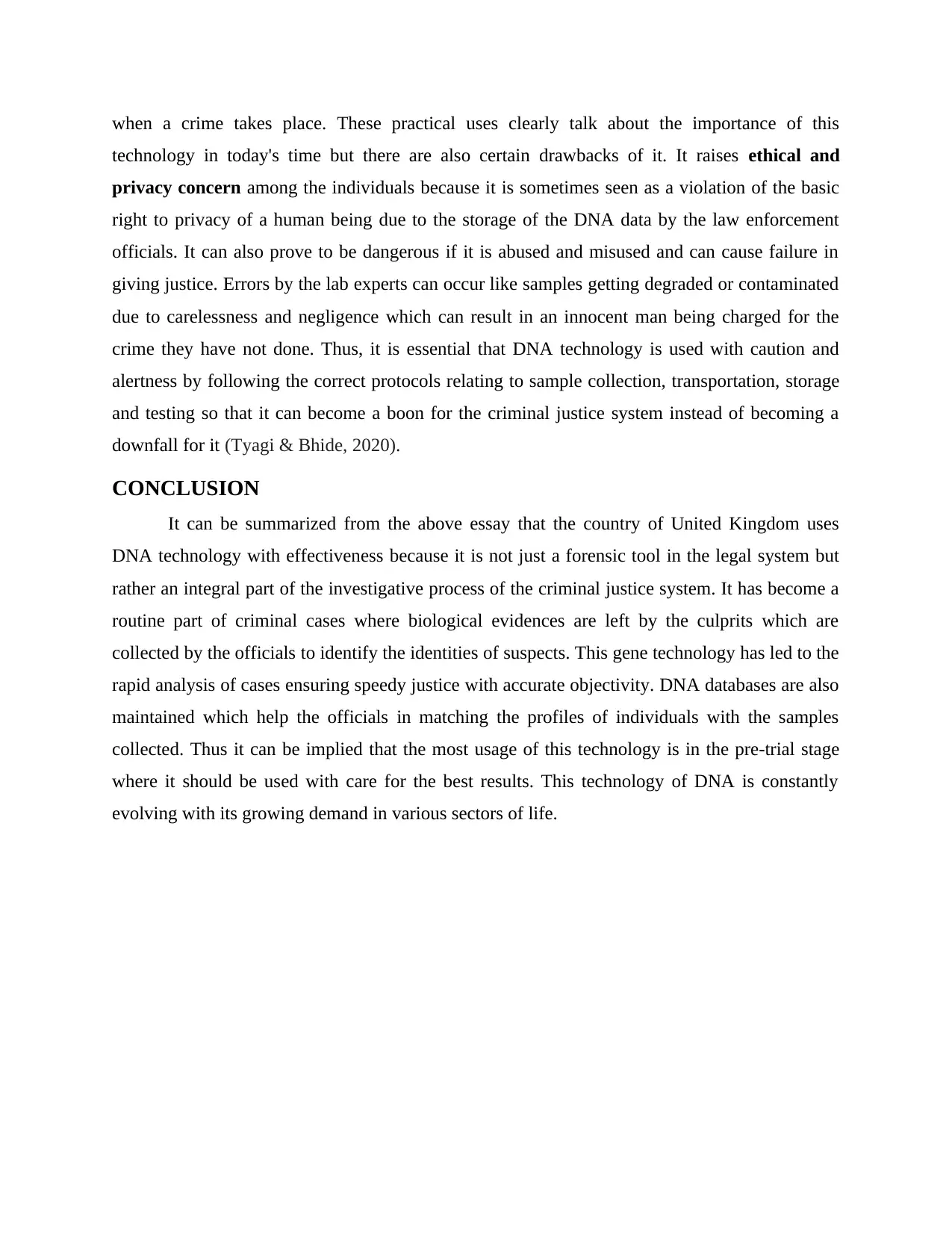
when a crime takes place. These practical uses clearly talk about the importance of this
technology in today's time but there are also certain drawbacks of it. It raises ethical and
privacy concern among the individuals because it is sometimes seen as a violation of the basic
right to privacy of a human being due to the storage of the DNA data by the law enforcement
officials. It can also prove to be dangerous if it is abused and misused and can cause failure in
giving justice. Errors by the lab experts can occur like samples getting degraded or contaminated
due to carelessness and negligence which can result in an innocent man being charged for the
crime they have not done. Thus, it is essential that DNA technology is used with caution and
alertness by following the correct protocols relating to sample collection, transportation, storage
and testing so that it can become a boon for the criminal justice system instead of becoming a
downfall for it (Tyagi & Bhide, 2020).
CONCLUSION
It can be summarized from the above essay that the country of United Kingdom uses
DNA technology with effectiveness because it is not just a forensic tool in the legal system but
rather an integral part of the investigative process of the criminal justice system. It has become a
routine part of criminal cases where biological evidences are left by the culprits which are
collected by the officials to identify the identities of suspects. This gene technology has led to the
rapid analysis of cases ensuring speedy justice with accurate objectivity. DNA databases are also
maintained which help the officials in matching the profiles of individuals with the samples
collected. Thus it can be implied that the most usage of this technology is in the pre-trial stage
where it should be used with care for the best results. This technology of DNA is constantly
evolving with its growing demand in various sectors of life.
technology in today's time but there are also certain drawbacks of it. It raises ethical and
privacy concern among the individuals because it is sometimes seen as a violation of the basic
right to privacy of a human being due to the storage of the DNA data by the law enforcement
officials. It can also prove to be dangerous if it is abused and misused and can cause failure in
giving justice. Errors by the lab experts can occur like samples getting degraded or contaminated
due to carelessness and negligence which can result in an innocent man being charged for the
crime they have not done. Thus, it is essential that DNA technology is used with caution and
alertness by following the correct protocols relating to sample collection, transportation, storage
and testing so that it can become a boon for the criminal justice system instead of becoming a
downfall for it (Tyagi & Bhide, 2020).
CONCLUSION
It can be summarized from the above essay that the country of United Kingdom uses
DNA technology with effectiveness because it is not just a forensic tool in the legal system but
rather an integral part of the investigative process of the criminal justice system. It has become a
routine part of criminal cases where biological evidences are left by the culprits which are
collected by the officials to identify the identities of suspects. This gene technology has led to the
rapid analysis of cases ensuring speedy justice with accurate objectivity. DNA databases are also
maintained which help the officials in matching the profiles of individuals with the samples
collected. Thus it can be implied that the most usage of this technology is in the pre-trial stage
where it should be used with care for the best results. This technology of DNA is constantly
evolving with its growing demand in various sectors of life.
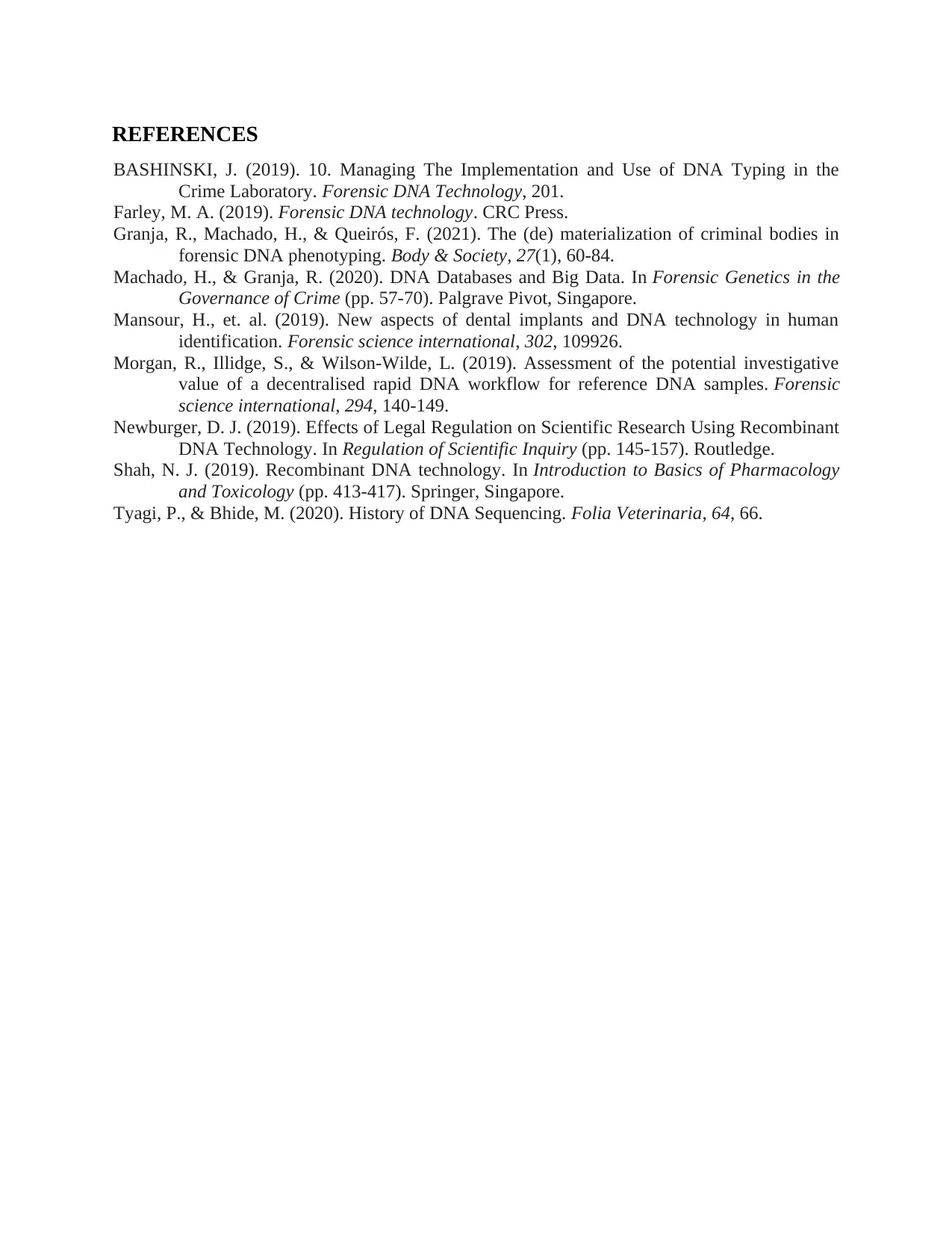
REFERENCES
BASHINSKI, J. (2019). 10. Managing The Implementation and Use of DNA Typing in the
Crime Laboratory. Forensic DNA Technology, 201.
Farley, M. A. (2019). Forensic DNA technology. CRC Press.
Granja, R., Machado, H., & Queirós, F. (2021). The (de) materialization of criminal bodies in
forensic DNA phenotyping. Body & Society, 27(1), 60-84.
Machado, H., & Granja, R. (2020). DNA Databases and Big Data. In Forensic Genetics in the
Governance of Crime (pp. 57-70). Palgrave Pivot, Singapore.
Mansour, H., et. al. (2019). New aspects of dental implants and DNA technology in human
identification. Forensic science international, 302, 109926.
Morgan, R., Illidge, S., & Wilson-Wilde, L. (2019). Assessment of the potential investigative
value of a decentralised rapid DNA workflow for reference DNA samples. Forensic
science international, 294, 140-149.
Newburger, D. J. (2019). Effects of Legal Regulation on Scientific Research Using Recombinant
DNA Technology. In Regulation of Scientific Inquiry (pp. 145-157). Routledge.
Shah, N. J. (2019). Recombinant DNA technology. In Introduction to Basics of Pharmacology
and Toxicology (pp. 413-417). Springer, Singapore.
Tyagi, P., & Bhide, M. (2020). History of DNA Sequencing. Folia Veterinaria, 64, 66.
BASHINSKI, J. (2019). 10. Managing The Implementation and Use of DNA Typing in the
Crime Laboratory. Forensic DNA Technology, 201.
Farley, M. A. (2019). Forensic DNA technology. CRC Press.
Granja, R., Machado, H., & Queirós, F. (2021). The (de) materialization of criminal bodies in
forensic DNA phenotyping. Body & Society, 27(1), 60-84.
Machado, H., & Granja, R. (2020). DNA Databases and Big Data. In Forensic Genetics in the
Governance of Crime (pp. 57-70). Palgrave Pivot, Singapore.
Mansour, H., et. al. (2019). New aspects of dental implants and DNA technology in human
identification. Forensic science international, 302, 109926.
Morgan, R., Illidge, S., & Wilson-Wilde, L. (2019). Assessment of the potential investigative
value of a decentralised rapid DNA workflow for reference DNA samples. Forensic
science international, 294, 140-149.
Newburger, D. J. (2019). Effects of Legal Regulation on Scientific Research Using Recombinant
DNA Technology. In Regulation of Scientific Inquiry (pp. 145-157). Routledge.
Shah, N. J. (2019). Recombinant DNA technology. In Introduction to Basics of Pharmacology
and Toxicology (pp. 413-417). Springer, Singapore.
Tyagi, P., & Bhide, M. (2020). History of DNA Sequencing. Folia Veterinaria, 64, 66.
1 out of 7
Your All-in-One AI-Powered Toolkit for Academic Success.
+13062052269
info@desklib.com
Available 24*7 on WhatsApp / Email
![[object Object]](/_next/static/media/star-bottom.7253800d.svg)
Unlock your academic potential
© 2024 | Zucol Services PVT LTD | All rights reserved.

